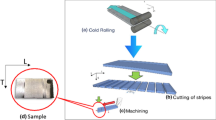Conclusions
In order to obtain a satisfactory structure and great and uniform hardness the water hardening of steel cermet parts must be performed under the following conditions:
-
1.
In order to avoid oxidation, decarburization, and lower hardness values, the heating for hardening purposes must be performed in a protective, preferably neutral, medium or in carboniferous fillings.
-
2.
If the cermet parts are to have a high degree of uniform hardness after hardening, they must have uniform density.
-
3.
In order to avoid excessive warping and the formation of soft austenite spots, the heating of parts for hardening must be performed at temperatures of 1073–1123°K. Water hardening at carburization temperatures (temperatures above 1173°K) is inadmissible, since large amounts of residual austenite, which lowers the hardness of hardened parts, are formed in this case in the structure of hypereutectoid cermet steel.
-
4.
In order to suppress the process whereby troostite spots are formed, it is recommended to cool the cermet parts abruptly and to disrupt the vapor jacket by imparting energetic movement to the parts in water or by using hardening in a stream of water.
Repeated hardening in which the above conditions are strictly observed is recommended for eliminating austenite or troostite spots that have developed in previous hardening.
Similar content being viewed by others
Literature cited
G. V. Samsonov and S. Ya. Plotkin, Production of Iron Powder [in Russian] Metallurgizdat, Moscow (1957).
I. M. Fedorchenko and R. A. Andrievskii, Fundamentals of Powder Metallurgy [in Russian] Izd. AN Ukr. SSR, Kiev (1961).
W. J. Doelker, Material and Methods,45, 122 (1957).
I. N. Kidin, Izv. Vuzov, Ferrous Metallurgy, No 11, 113 (1960).
J. de Groat, Production of Metal Powder Parts [Russian translation] Mashgiz, Moscow (1960).
Metalworking Production, March 9th (1960).
Steel,149, N 3, 134 (1961).
V. E. Mikryukov and N. Z. Pozdnyak, Coll.: Powder Metallurgy, Transactions of the Scientificotechnical Conference Moscow (1954) p. 37.
I. D. Radomysel'skii and M. A. Kuzenkova, Poroshkovaya Metallurgiya 456, (1961).
A. A. Shmykov, A. A. Kokorev, and L. G. Erchenko, Manufacture of Parts According to Powder Metallurgy Methods[in Russian] No. 1, TsITÉIN, 1 (1961).
W. J. Doelker, High Density Iron Powder Parts, Proceedings of the 12th Annual Meeting of the Metal Powder Association, Cleveland, Ohio; 65 (1956).
Author information
Authors and Affiliations
Rights and permissions
About this article
Cite this article
Zhornyak, A.F., Radomysel'skii, I.D. Characteristics of the hardening of dense cermet steels. Powder Metall Met Ceram 3, 316–323 (1964). https://doi.org/10.1007/BF00774177
Received:
Issue Date:
DOI: https://doi.org/10.1007/BF00774177




